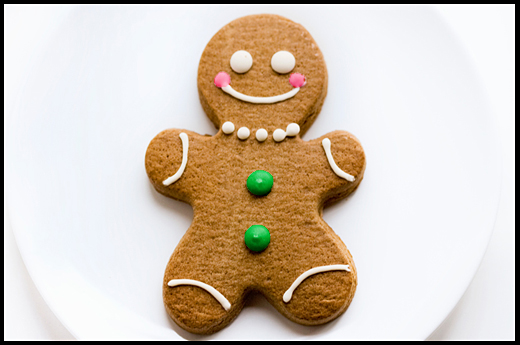 by William Davis, MD, author of Wheat Belly
by William Davis, MD, author of Wheat Belly
Cookies, cakes, pies, cheesecakes, candies…I call the holidays the Annual Wheat and Sugar Frenzy. During these days of holiday get-togethers, treats at the office, gifted goodies, and overindulgent dinner parties, we can easily gain around 5 to 10 pounds. And once you start down the holiday goody path, it’s tough to stop. But it doesn’t have to be this way.
What makes those pounds so easy to gain and the goodies so hard to resist? Is it because the treats are so plentiful and available? Is it because they are just so tasty? No, it’s the wheat.
Modern wheat (flours that originate from the high-yield, semi-dwarf strains of wheat that were created by geneticists in the 1960s and ’70s) contains an appetite stimulant called gliadin. While gliadin proteins have always been a component of the wheat plant, they have undergone extensive change with the genetics efforts to increase yield. People who consume modern wheat—and along with it, the appetite stimulant, gliadin—consume an additional 400 to 800 calories per day, every day. And those additional calories don’t come from salmon or olive oil, they come from cookies, candy, pies, cakes, and other goodies. Those are the calories that make us gain weight, specifically belly fat.
For some people, sugary foods (even without wheat) also increase appetite and consumption of goodies, though, in my experience, an increased desire for sugary snacks is nearly always triggered by first consuming wheat. Nonetheless, be aware that sugary snacks by themselves can add to increased desire.
Is there a way to enjoy the holidays without being exposed to the appetite-triggering effects of sugary and wheat-containing snacks? Yes, there is, and it can be done in ways that your friends and family will hardly notice the difference!
• Change your flour. First of all, rather than creating your holiday treats with wheat flour, use healthy replacement flours such as almond meal/flour, coconut flour, ground golden flaxseed, and garbanzo bean flour. These flours, unlike wheat flour, do not trigger appetite, nor do they cause blood sugar to go sky-high the way wheat flour can. (Two slices of whole wheat bread, for instance, raise blood sugar more than 6 teaspoons of table sugar, a simple fact most dietitians simply overlook! Wheat flour sugared up, as in pie or cookies, makes it go even higher.) You can create perfectly beautiful and delicious gingerbread cookies or pumpkin pie using almond meal, eggs, and other simple ingredients.
• Steer clear of gluten free. I advocate that we NEVER use the usual gluten-free flours sold; the cornstarch, rice flour, potato starch, and tapioca starch used in these flours are among the short list of foods that raise blood sugar and trigger growth of belly fat even more than wheat! This also applies to the many gluten-free foods sold: Yes, it is good to be wheat- and gluten-free, but we don’t want to replace a problem—modern wheat—with another problem—gluten-free junk carbohydrates that make us gain weight and develop diabetes
• Use alternative sweeteners. Choose benign sugar replacements. My favorites: liquid stevia, powdered stevia (pure stevia extract or stevia extract with inulin, but not maltodextrin, which is just a form of sugar), Truvía, lo han guo, erythritol, and xylitol. These sweeteners do not raise blood sugar and do not trigger cravings. It means that you and your family can have cookies, cakes, pies, and even candies that don’t have the adverse health effects of standard sugar-sweetened baked goods and candies.
Yes, that means finding a somewhat different way of creating all those beautiful and enticing holiday goodies. But it also means enjoying them without worrying about calories, without worrying about awful health consequences, without worrying about gaining weight, and without dreading the otherwise inevitable post-holiday remorse. How great to enjoy your holiday foods and feasts without worries!
For holiday recipes following this new style of baking, go to wheatbellyblog.com, as well as the new Wheat Belly Cookbook, to be released December 24, 2012.
 Renowned cardiologist William Davis, MD, is the author of the New York Times best-seller Wheat Belly: Lose the Wheat, Lose the Weight, and Find Your Path Back to Health (Rodale, 2011).
Renowned cardiologist William Davis, MD, is the author of the New York Times best-seller Wheat Belly: Lose the Wheat, Lose the Weight, and Find Your Path Back to Health (Rodale, 2011).




Thank you for this informative article. It’s not clear to me if Truvía, lo han guo, erythritol, and xylitol should be avoided. Please confirm if they are safe or not. Thank you.
This man knows what he’s talking about. I tried eating this way with so many improvements. My asthma has virtually disappeared, my reflux is better, my weight is less, my diabetes is better, lower blood sugars. I cheated and ate a heavy pie crust and was wheezing and congested shortly after. Almond flour surprised me by being delicious – coconut flour is good too in certain things. Give it a try for a trial and see if you feel better! Stevia is also good as a sweetener – KAL stevia is my favorite and leaves no bitter aftertaste.
Does this hold true with Organic Wheat Flours?